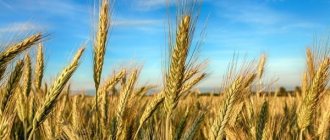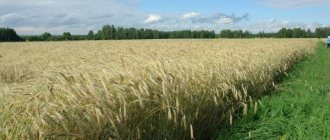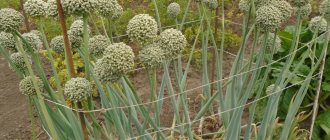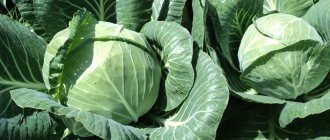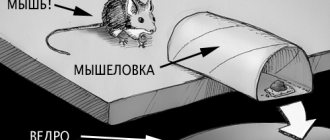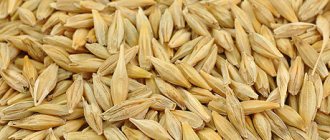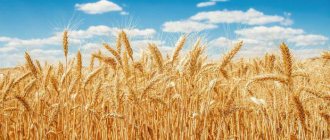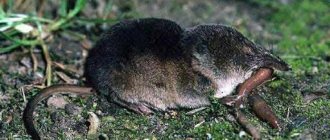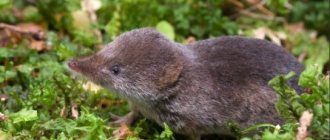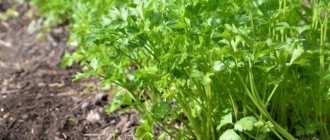Rye as green manure
Prolonged sowing of the soil with certain crops leads to land depletion and an inevitable decrease in yield. Fertilizer application effectively solves this problem. For many centuries, our ancestors used rye as a “green fertilizer” - green manure. This traditional recipe has not lost its relevance today.
On what soils is rye used?
Green manures are plants that are plowed into the soil to improve its composition, enrich it with useful nitrogen, and also to inhibit the growth of weeds . The process causes accelerated formation of humus, facilitates aeration and water flow.
Rye is one of the most popular green manures. winter variety is most often used .
Using rye as green manure
Due to its unpretentiousness, rye is suitable for growing on any soil . Rye successfully loosens clay soil, and sandy soil protects against weathering. It takes root well in wetlands and grows even in the most depleted soil.
The cereal shows good germination in areas with arid climates. Thanks to its developed fibrous system, the plant is able to accumulate moisture so that during dry periods it does not suffer from a lack of water.
However, the optimal conditions in which rye feels most comfortable are soils with a neutral or weak acidity level. It is also allowed to sow it in soil with weak salinity.
Rye enriches the soil well with nitrogen, potassium and phosphorus . It successfully suppresses the growth of weeds and prevents the spread of fungal infections, and helps to destroy nematodes.
Rye as a green manure is not suitable for all crops
Since the grain is sown at the end of summer or early autumn, it begins to grow quite early in the spring. This happens when the temperature rises by only 2-3˚C. By the second half of April, the seedlings of the crop reach 30 cm and are suitable for repeated mowing. Based on these features, rye is most often used as green manure for potatoes and other late crops.
It is sown in areas reserved for:
- cucumbers;
- zucchini;
- pepper;
- cabbage;
- eggplant;
- tomatoes;
- strawberries;
- beets;
- pumpkin
After green manure, the soil becomes looser, as well as air- and moisture-permeable. Moreover, it is enriched with many minerals, because during decomposition the culture releases a sufficient amount of phosphorus, nitrogen and potassium into the soil. At the same time, this cereal helps to destroy pests such as wireworms and nematodes.
In addition, planting rye after potatoes inhibits the growth of harmful weeds:
- wheatgrass;
- shiritsy;
- bindweed;
- quinoa;
- sow thistle
Farmers practice using several green manure crops at once. Sowing oats, vetch, ryegrass and phacelia in combination with rye maximally saturates the area with all useful macro- and microelements.
Rye is not a desirable precursor for nightshades and all other grain crops.
As you can see, it is better to use winter rye as green manure in the fall, because it quickly gains green mass in the spring. Of course, the farmer will have to decide for himself when to mow it and incorporate it into the soil. If he does everything correctly, the garden will please him with a rich harvest.
For which crops is it recommended?
This unpretentious grass gets along well with most plants. After applying this green manure, high yields are observed in:
- potatoes;
- tomatoes;
- zucchini;
- cucumbers;
- radish;
- pumpkin and melon crops.
Technology for growing rye as green manure: how many seeds are needed and how to care for the seedlings
Many gardeners prefer to sow cereal crops as the site becomes vacant. Others are waiting for the time when they will free it completely. They divide it into beds with a step of 15 cm, or distribute the seeds in a chaotic manner, sowing in bulk. However, after this they do not go on vacation, but continue to look after their lands.
There are several features of growing rye as green manure:
- Agricultural technology of sowing. For 1 hectare of personal plot you will need to prepare up to 1-3 kg of ripened seeds. The depth of seeding of grains is from 2 to 5 cm. To achieve such a precise effect, some farmers use a rake.
- Watering. Most of the rhizomes of the crop are mainly concentrated in the upper layer of the soil. Therefore, the plant urgently needs sufficient moisture. To do this, at the stage of preparatory work, if there was no rain in September, the area is thoroughly irrigated with water.
- Feeding. Although rye survives on severely depleted soils, agronomists still recommend periodically fertilizing the soil. Nitrophoska (at a rate of 20 g/m²) is often used as such a nutritional supplement.
For sowing, it is recommended to buy last year’s seed. Seeds that are too young simply do not have time to go through the full ripening process, and therefore have low germination. In addition, farmers are urged not to plant this cereal crop near fruit trees or shrubs. Otherwise, the plant will absorb all the available moisture reserves in the summer cottage.
The depth of seed placement is different for each type of soil. For sandy loams this figure is 5 cm, for clayey ones - 2 cm, and for all others - 3 cm.
Advantages
Benefits of rye as green manure
Rye as a green manure has many advantages . She:
- is an ideal soil loosener;
- protects the soil from weeds;
- promotes the formation and preservation of useful elements in the soil;
- unique elements of the root system have the ability to repel nematodes.
After planting plants in soil enriched with rye, the yield of most crops increases by 30–40% .
Agronomists recognize the effectiveness of both methods of improving soil fertility - plowing green mass into the ground and leaving winter rye under the snow.
The benefits of green organics
Sideration is the process of fertilizing the soil with plants. For more than 100 years, agronomists have been using green manure as a source of nutrition and soil restoration on large plots of land and small farms.
Historical fact . The method of enriching the earth with green fertilizers has been known since ancient times. In Central and Middle Asia it was used 3 thousand years ago. Since the 19th century, green manure has become popular in Europe.
Green manures are natural organic matter, green fertilizers that ensure the natural circulation and exchange of useful substances in the soil. The main advantage is environmental friendliness and safety for the environment.
World agronomic practice and science have proven that natural fertilizers increase soil fertility by 3-5 times. In addition, these are “long-range” fertilizers, a kind of advance payment for the future. They create favorable conditions for the growth and development of subsequent planting of plants (vegetables, root crops, berries).
Benefits of green organics:
- stimulates the development of soil organisms (worms, larvae, microorganisms);
- the roots of green manure plants optimize the mechanical structure of the soil, form a system of bark canals that accumulate nitrogen, starch, proteins, sugar and microelements;
- plant residues - natural mulch and compost, protecting the soil from weathering, blowing away and erosion;
- mulch from the mowed above-ground part prevents excessive growth of weeds (weed seeds remain without access to sunlight and do not germinate);
- green mulch protects the soil from drying out (gradually rotting fertilizer stems ensure uniform nutrition and hydration);
- a laying layer of winter green manure prevents soil damage by wind erosion; the fertile layer is protected from being washed away along the slope of the site.
Flaws
A few disadvantages include :
- attractiveness of the cereal root system for wireworms. Having settled in the fertile layer, they damage potato tubers and tender tomato roots. However, this problem is easily solved by simultaneously sowing rye and mustard seeds as green manure, which has the ability to repel these pests;
- high water requirement during germination period. Therefore, it is winter rye that is recommended to be used as fertilizer;
- predisposition to infection by insects - aphids, ticks, mosquitoes, bedbugs. To prevent their occurrence, the soil should be treated with an insecticide in advance.
What to do with green manure
After the rye has grown, it is worth deciding on ways to mulch the stems of the cereal plant . There are several options for using rye as green manure.
Digging up
Many summer residents are interested in the question of whether it is worth digging up green manure and when is the best time to do it.
In March-April, the area where rye was grown is plowed . This is done as soon as the snow melts, so that a sufficient amount of moisture remains in the ground.
Attention. At least 3-4 weeks must pass between digging up the green manure and planting the main plants, so that the stem and root parts of the rye have time to decompose in the ground and release their beneficial substances to the soil.
When to sow rye and incorporate it into the soil
Rye seeds
Soil greening with rye can be carried out with winter and spring varieties .
Spring rye
Typically, spring rye is sown in early spring in order to have time to mow at least 3 weeks before planting the main crops. This period is maintained so that the embedded green mass and the root system remaining in the soil can begin to decompose. Otherwise, it will interfere not only with plowing the soil, but even with the usual loosening of its surface layer. And this may make replanting impossible.
Some agronomists practice planting spring cereals in the fall , after the completion of harvesting the main crops . The grown rye is mowed immediately before the onset of frost and, without covering, is left on the surface.
Winter rye
But much more often winter rye is used as green manure. In the first year after planting, this biennial plant does not spike and is successfully used as an environmentally friendly fertilizer. The stems are mowed when their height reaches 30 centimeters. During the season, winter rye can be harvested 3 times , while up to 300 kilograms of green mass are harvested from one hundred square meters.
Cold does not harm frost-resistant rye; it overwinters well under the snow, resuming its growth with the first rays of spring. Overgrown stems are mowed until spikelets appear. Then the soil must be thoroughly processed with a flat cutter to avoid unwanted germination, covered with the resulting green mass and left to rot for several weeks. It is important to plant it in the ground in a timely manner so as not to miss the time for planting the main crops.
Do not plant green manure too deeply. On sandy and sandy loam soils, the placement depth should not exceed 10–15 cm, on others - 8 cm .
Care measures
At the beginning of their growth, green manure in the garden needs watering, but only if there has been no rain for a long time and the soil has dried out. Watering must be taken responsibly, especially in arid regions. If at the beginning of growth the plants feel a lack of moisture, they will not be able to get much greenery. Once their roots have grown sufficiently long, they will no longer need to be watered. There is no need to fertilize cereal plants with anything, but you can add fertilizers to the soil before planting, for example, nitroammophoska in the amount of 20 g per 1 sq. m. m.
Demand for sowing
Rye has food and feed value. In addition, this cereal crop is an excellent green manure. Bread is baked from rye, and its grain serves as feed for farm animals. Flour is fed to pigs, and bran is fed to cattle.
Rye is the most important national product of Russia, but since Soviet times its cultivation has been steadily declining. If in 1990 in the Russian Federation 8 million hectares were allocated for rye, then in recent years the gross harvest is 2.5-3 million tons. Wheat today turned out to be more profitable to grow than rye. However, Russia continues to be the leading producer of rye. Only Poland and Germany can compete with the Russian Federation. The most rye - 20% - is grown in Tatarstan and Bashkiria.
Which is better - rye or oats?
When choosing a cereal crop for soil greening, gardeners most often choose rye. The advantages of this crop are much greater than those of oats:
- Rye is not afraid even of severe frosts . If oats need to be mowed and planted in the ground in the fall, rye can be left until spring and you can start preparing the beds just before planting the cultivated plants.
- Unpretentiousness is one of the characteristics of rye . This crop does not need frequent watering, because its roots can grow up to 1 m and easily obtain the necessary moisture from the soil. Watering rye is necessary only during the period of grain germination or severe drought.
- Rye can be grown in a separate plot and only the greens can be used for planting in other beds . This allows you to mow the plant several times per season. Oats actively absorb potassium from the soil, and in order to compensate for its deficiency, it is necessary to plant green manure in the same bed, otherwise it will subsequently be unsuitable for growing vegetable crops.
Another advantage of rye over oats is that this crop more actively fights weeds. It completely displaces even the most stubborn weeds.
Rye is an excellent green manure if you need to fertilize depleted soil, get rid of weeds, and improve the soil structure. The only thing you need to remember is that you should not constantly use the same crop for green manure. It will be more useful to periodically change the green manure. This will provide the land with all the necessary elements and annually receive a generous harvest with virtually no use of chemical fertilizers.
Tips and tricks
Advice from experienced farmers on the use of rye crops:
- Wait until the rye grows and starts to spike. By mowing such shoots, you will prepare nutritious hay for goats and cows for the winter. Thus, not only green fertilizer is obtained, but also complete food for animals.
- Rye straw can be burned to produce ash. This fertilizer is also extremely useful. It has been used for centuries either in dry form for sprinkling plants or in liquid form for feeding vegetable or fruit crops.
When to plant
It’s not for nothing that rye is called a universal green manure - it can be sown throughout the entire season. The most common use of the crop is sowing in the fall . At this time, numerous mycorrhizal fungi are formed on the root shoots of the cereal, which process microelements into a form accessible to plants.
In winter, green manure will also protect the ground from freezing and retain snow. The optimal time for planting is 2-4 weeks before the first frost. Although rye is frost-resistant, the grains need consistent heat to germinate.
Sowing green manure can also be done in the spring . It is also important to calculate the timing correctly here. Keep in mind that it will take about 6 weeks from emergence to heading. Add more time for the green mass to rot - 2-3 weeks. Only after this can you start planting seedlings or sowing seeds of cultivated plants.
If there is empty land, cereals are sowed even in summer . There are no specific deadlines - the main thing is not to do it during a drought. In the absence of rain, the grains will germinate, but the green mass will grow extremely slowly. The sprouts will be dry and tough and will take extra time to rot.
Winter rye description
Rye is a herbaceous plant, annual or perennial, belonging to the large family of cereals. Its name in Latin is Secale cereale, which means “sowing rye”. Within the species there are wild subspecies and over forty cultivated varieties.
Plant differences relate to the following points:
- appearance and nutritional characteristics of grains;
- spine development;
- ear length;
- pubescence of the stem.
Root system. Rye has a fibrous root system, buried 1-2 m deep. This plant has powerful and developed roots, which are especially effective on light sandy soils. Rye roots, consisting of primary (embryo) and secondary (nodal) roots, quickly absorb nutrients contained in poorly soluble compounds. The grain, immersed in the soil, forms 2 tillering nodes. One is located in depth, the second is near the surface, and it becomes the main one. Rye is characterized by intensive tillering - the plant forms from 4 to 8 shoots, and if favorable conditions are created - 50-90.
Latest articles for gardeners, gardeners and flower growers
Wolfsbane herbaceous plants for open ground
Winter onion planting in autumn
Frost-resistant grape varieties for Central Russia without shelter
Tomato varieties resistant to late blight for open ground
Stem. The rye stalk is a hollow straw consisting of several knees (from 4 to 7) connected by nodes. The lower internodes are thicker than the upper ones - 6-7 mm versus 2-4 mm. The stem is erect, pubescent under the spike, and then bare. The height of cultivated rye is limited to 1.5 m, wild species are higher - up to 1.8 m or more. The stem and leaves are green, but due to the waxy coating they appear bluish. As they ripen, the color of the stem and leaves changes, first becoming gray-green, then gray-yellow and finally golden yellow.
Ear. Rye has an inflorescence in the form of a spike, consisting of 2 or 3 flowering spikelets attached to the stem. The shape of the grain is oblong or oval, slightly flattened on the sides. The top of the grain is bare or pubescent. Each variety of rye has its own ear length, it varies between 8-17 cm. The weight of the grain depends on the variety:
- for large-grain varieties, 100 seeds weigh more than 38 g;
- for varieties with grains above average size - 30-38 g;
- for varieties with medium-sized grains – 20-30 g;
- for small-grain varieties - up to 20 g.
Results and conclusions
Rye is a unique green manure that helps to grow an abundant, environmentally friendly harvest of almost all fruits and vegetables. Sowing winter rye is possible both in the south and in central Russia, in the Leningrad region and Moscow region, in Siberia and the Urals, since it adapts perfectly to any climatic conditions.
Rye is a safe precursor for potatoes, tomatoes, cucumbers and cabbage, protecting them from pests. Sowing winter rye does not require special knowledge and skills, so even novice summer residents can cope with it.
Crop rotation
The predecessors of winter rye are selected so as to create favorable conditions at the time of sowing the rye:
- optimal soil structure;
- no weeds;
- absence of soil pests;
- optimal soil moisture and nutrition.
Precursors are selected depending on climatic conditions and soil characteristics. The best predecessors for certain regions of Russia are in Table 1.
Table 1
| Region | The best predecessors |
| Non-Black Earth Region |
|
| Cis-Urals, North-Eastern regions | clean, well-fertilized steam |
| Central Black Earth Zone |
|
| Volga region (forest-steppe zone) |
|
| Volga region (steppe zone), Siberia | pure couples |
Rye itself is an excellent predecessor; one gives high yields in one place for 2 years in a row. But when rye is grown in one place for a long time, yields begin to decline.
